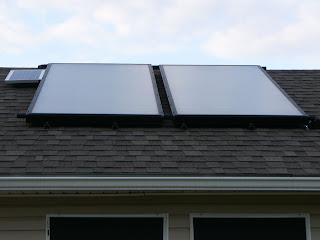 Living out in the country is great! But I do have to trade a few city conveniences for our homestead. One of those is curbside recycling. If you live in town, recycling requires little effort, but in the country it requires a bit of dedication. We recycle everything we can and have only a small kitchen garbage bag of trash a week. We recycle veggie food scraps, coffee grounds, a bit of paper and paperboard tubes in the compost pile. We recycle 1-7 plastics, all colors of glass, steel cans, paper, cardboard and paperboard by taking it to a recycling dropoff center outside Prairie Grove. I take the aluminum to Vaughn Battery and Recycling. The price per pound for aluminum varies but each trip to vaughn helps pay for the next case of beer! The bins you see here are our recycle bins. I have a small crate in the house where we collect the recycling, then once a week I move it out to the shop and sort into these bins. Then about once every 6 weeks I'll take a truck load to the recycling center. City curbside recycling is convenient, but they don't necessarily take all types of recyclable material. Most in our area only accept #1 and #2 plastics, however the drop off center outside prairie grove accepts all 7 plastic resin code types. If your local pickup doesn't include all plastics or has other restrictions look for a self-service drop-off point in your area. This will allow recycling of much more material than a curbside pickup, such as yogurt and "butter" tubs, ketchup, mustard, honey, and medicine bottles, cd jewel cases, and thousands of other products that would otherwise go into a landfill.
Living out in the country is great! But I do have to trade a few city conveniences for our homestead. One of those is curbside recycling. If you live in town, recycling requires little effort, but in the country it requires a bit of dedication. We recycle everything we can and have only a small kitchen garbage bag of trash a week. We recycle veggie food scraps, coffee grounds, a bit of paper and paperboard tubes in the compost pile. We recycle 1-7 plastics, all colors of glass, steel cans, paper, cardboard and paperboard by taking it to a recycling dropoff center outside Prairie Grove. I take the aluminum to Vaughn Battery and Recycling. The price per pound for aluminum varies but each trip to vaughn helps pay for the next case of beer! The bins you see here are our recycle bins. I have a small crate in the house where we collect the recycling, then once a week I move it out to the shop and sort into these bins. Then about once every 6 weeks I'll take a truck load to the recycling center. City curbside recycling is convenient, but they don't necessarily take all types of recyclable material. Most in our area only accept #1 and #2 plastics, however the drop off center outside prairie grove accepts all 7 plastic resin code types. If your local pickup doesn't include all plastics or has other restrictions look for a self-service drop-off point in your area. This will allow recycling of much more material than a curbside pickup, such as yogurt and "butter" tubs, ketchup, mustard, honey, and medicine bottles, cd jewel cases, and thousands of other products that would otherwise go into a landfill.Here are some links if you are thinking of recycling too!
http://www.ides.com/resources/plastic-recycling-codes.asp - List of plastic resin codes and products made from recycled plastics
http://www.bmswd.com/recyclin.htm - Boston Mountain Solid Waste District recycling centers
http://www.bcswd.com/drop-off.htm - Benton County Solid Waste District recycling centers
http://www.fcsolidwaste.com/recyclinglocations.html - Faulkner County Solid Wast District recycling center
http://www.adeq.state.ar.us/solwaste/branch_recycling/ - Arkansas Department of Environmental Quality recycling branch
http://www.epa.gov/epawaste/wycd/catbook/index.htm - EPA's consumers guide to reducing solid waste





 This post focuses on a passion for many, a chore for some, but an enjoyable pastime for me and at least some of you. Gardening is good for each of us that endeavors in the pastime. It is a low impact exercise, it provides healthy whole foods for consumption and it reduces the amount of money we pay to have vegetables shipped across the country to feed us. This spring I put in two 4' x 8' raised beds. I plan to add 1 or possibly 2 more raised beds next year. The beds were built from railroad ties and I added horse manure, topsoil and homegrown compost (post coming soon) This year we grew: grape,cherry, lemon boy, Arkansas traveler, and early girl tomatoes, as well as yellow squash, cucumbers, yellow bell peppers, cantaloupe, okra, and vidalia onions. In our herb planters we grew genovese basil, flat leaf parsley, rosemary, peppermint, and banana peppers.
This post focuses on a passion for many, a chore for some, but an enjoyable pastime for me and at least some of you. Gardening is good for each of us that endeavors in the pastime. It is a low impact exercise, it provides healthy whole foods for consumption and it reduces the amount of money we pay to have vegetables shipped across the country to feed us. This spring I put in two 4' x 8' raised beds. I plan to add 1 or possibly 2 more raised beds next year. The beds were built from railroad ties and I added horse manure, topsoil and homegrown compost (post coming soon) This year we grew: grape,cherry, lemon boy, Arkansas traveler, and early girl tomatoes, as well as yellow squash, cucumbers, yellow bell peppers, cantaloupe, okra, and vidalia onions. In our herb planters we grew genovese basil, flat leaf parsley, rosemary, peppermint, and banana peppers.









